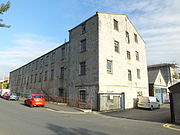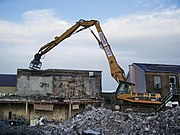Clitheroe in Lancashire, England is known for limestone quarrying, but it also developed a cotton industry.
The mills
| Name | Architect | Location | Built | Demolished | Served (Years) |
|---|---|---|---|---|---|
| Albion Mill | SD 53°52′23″N 2°23′13″W / 53.873°N 2.387°W [1] | ||||
| Brewery Mill aka Claremont Mill | SD749415 53°52′08″N 2°22′59″W / 53.869°N 2.383°W | ||||
| Notes: Built in 1788 as a brewery, it became a printworks in 1809 and a sizing house in 1823. In 1834 a 7 storey spinning mill with weaving sheds was built, the engine was by William Roberts & Co of Nelson.The mill burnt down in 1896 but was reconstructed. In 2006 it had become a furniture warehouse with shops. [1] [2] [3] | |||||
| Brooks Mill | SD 53°52′26″N 2°23′10″W / 53.874°N 2.386°W [1] | ||||
| Commercial Mill | SD 53°51′47″N 2°24′00″W / 53.863°N 2.400°W [1] | ||||
| Foulsykes Mill | SD 53°52′05″N 2°23′56″W / 53.868°N 2.399°W [1] | ||||
| Holmes Mill aka Thornbers Mill and possibly Greenacre Mill | SD742414 53°52′05″N 2°23′42″W / 53.868°N 2.395°W | 1820 | Standing | 204 | |
 |
Notes: This is a complex combined mill which has housed spinning, weaving and printing, spinning and sizing in an 1823 four storey 13 bay block, and an 1830s block. The offices and warehouses were built in 1843 and weaving sheds in 1853. At this time there were 16,000 mule spindles and 707 looms. It was powered by at least two beam engines supplemented by a 24" x 3' stroke horizontal. These were replaced in 1910 by a 350 IHP Clayton, Goodfellow & Co. Ltd horizontal cross-compound type. This worked at 68rpm [4] [5] [6] | ||||
| Jubilee Mill | SD 53°52′23″N 2°22′59″W / 53.873°N 2.383°W | 1887 | Standing | 137 | |
 |
Notes: These were single storey stone built power weaving sheds built in 1887 by The Clitheroe Jubilee Mill Company Ltd. There was a sandstone engine house with a brick chimney. The current occupants are Trutex, the large school uniform manufacturing company. [3] [7] | ||||
| Low Moor Mill | SD729418 53°52′19″N 2°25′01″W / 53.872°N 2.417°W | ||||
 |
Notes: The first mill, a five storey spinning mill opened in 1782. It and 28 workers cottage were sold to Parker and Parker in 1791, and then in 1799 to Garnett and Horsfall. The mill was demolished and replaced. In 1840, power looms were introduced further buildings and a substantial number of houses were added, creating Low Moor, Lancashire, by 1928 when the mill closed, there were 200 houses, nine shops, a school, church and chapels. The 1840 mill was powered by 3 iron waterwheels on a leet from the River Ribble, supplemented by beam engines. [8] [1] | ||||
| Primrose Mills | SD738407 53°51′43″N 2°24′00″W / 53.862°N 2.400°W | 1810 | Standing | 214 | |
 |
Notes: This site contained a late eighteenth century spinning mill, which was replaced by a calico printworks in 1810. This became a bleachworks and a dyeworks and a new spinning mill was added in 1860. The site contains a mill-pond and a mill-lodge, both fed by the Mearley Brook. [9] | ||||
| Queensway Mill | SD 53°52′05″N 2°23′31″W / 53.868°N 2.392°W | ||||
 |
Notes: Maybe now Homebase [1] | ||||
| Salford Bridge Mill | SD 53°52′05″N 2°23′31″W / 53.868°N 2.392°W | 1833 | 173 | ||
| Notes: Salford derives from 'the ford between willows'and was where the main road south crossed the Mearley Brook. A weaving shed and a spinning mill was set up here between from 1833 to 1860, though there was an earlier mill on the site. The weaving sheds survived until 2006, the current occupants are now Sainsburys [1] [3] | |||||
| Shaw Bridge Mill | SD 53°52′12″N 2°23′17″W / 53.870°N 2.388°W [10] | ||||
| Shaw Bridge Old Mill | SD 53°52′19″N 2°23′13″W / 53.872°N 2.387°W [11] | ||||
| Upbrooks Mill | SD 53°52′30″N 2°22′26″W / 53.875°N 2.374°W [12] | ||||
| Victoria Mill | SD 53°52′05″N 2°23′56″W / 53.868°N 2.399°W | ||||
| Notes: Demolished and the site is used for housing. [1] | |||||
| Waterloo Mill | SD 53°52′08″N 2°22′59″W / 53.869°N 2.383°W | ||||
 |
Notes: History of the Jet Engine see: Frank Whittle | ||||
| [13] | |||||
See also
- Category:Lists of textile mills in the United Kingdom
- List of mills owned by the Lancashire Cotton Corporation Limited
- List of mills in Lancashire
References
- ^ a b c d e f g h i Lancashire? (Map) (1st? ed.). 1 : 2,534. County Series?. Ordnance Survey. 1890.
- ^ Historic England. "Brewery Cotton Mill (1587360)". Research records (formerly PastScape). Retrieved 26 September 2015.
- ^ a b c Egerton Lee Consultancy (2006). Clitheroe:Historic Towns Survey. Lancashire County Council. p. 38.
- ^ Historic England, "Holmes Mill, Clitheroe (1413649)", National Heritage List for England, retrieved 26 September 2015
- ^ Historic England. "Holmes Mill (1572997)". Research records (formerly PastScape). Retrieved 26 September 2015.
- ^ Nazia Parveen (18 August 2010). "Clitheroe's last surviving mill taken over". Lancashire Telegraph. Newquest. Retrieved 26 September 2015.
- ^ Historic England. "Jubilee Mill (44723)". Research records (formerly PastScape). Retrieved 26 September 2015.
- ^ Egerton Lee Consultancy (2006). Clitheroe:Historic Towns Survey. Lancashire County Council. p. 26.
- ^ Historic England. "Primrose Mill (1584617)". Research records (formerly PastScape). Retrieved 26 September 2015.
- ^ Historic England. "Shaw Bridge Mill (1576845)". Research records (formerly PastScape). Retrieved 26 September 2015.
- ^ Historic England. "Shawbridge Old Mill (1591704)". Research records (formerly PastScape). Retrieved 26 September 2015.
- ^ Historic England. "Upbrooks Mill (1576845)". Research records (formerly PastScape). Retrieved 26 September 2015.
- ^ Ashmore 1982, pp. 197, 198
Bibliography
- Ashmore, Owen (1982). The industrial archaeology of North-west England. Manchester University Press. ISBN 0-7190-0820-4. Retrieved 25 June 2009.
External links
Wikimedia Commons has media related to
Textile mills in Clitheroe.
